Impressive looking, but simple enough for beginners, this super-easy pumpkin spice soap combines pumpkin puree and goat milk with fall spices, making a soap that’s nourishing and wonderfully fragrant.

With autumn, comes cooler nights and shorter days. Halloween and Thanksgiving bring all sorts of fun pumpkin and apple spice recipes.
In celebration of this pumpkin spice time of year, I’ve decided to make a pumpkin spice soap.
What I love about this soap is that the scent lasts quite a bit longer than most naturally scented soaps. Perhaps it’s because it uses a combination of both essential oils and the actual spices. Or, maybe it’s just because the fragrance of these spices is more persistent.
Either way, I’m really happy with the final outcome.
A beginner recipe
If you have never made soap before, don’t worry. This soap is very simple to make. I purposely based this soap recipe on my easy, beginner soap recipe.
Because this recipe uses milk and adds a swirling technique, it is a bit more complicated than the other recipe. If that worries you, begin with the other recipe. If you’re adventurous, though, give this one a try! By following the directions carefully, even as a beginner, you shouldn’t have any problems.
My beginner soap is a tried and true recipe that only uses simple, easy-to-find oils. It also has a relatively long working time. The longer working time is perfect for beginners because it gives plenty of time to add in fragrance oils and spices. You should also have time to spare to swirl them together as I did.
To show how simple it is to adapt a soap recipe, I kept the main recipe exactly as it was. So, this recipe uses the same basic oils in the same amounts as the original recipe. For that reason, it also uses the same amount of lye and a similar amount of water. (This time, though, I switched out half of the water for goat milk. I also reduced it slightly because of the water in the pumpkin puree.)
Introducing new soap techniques
The beginner soap is great, but it’s also rather basic. I often get questions from readers who love that recipe, but who want to incorporate other ingredients. Today we will cover some of the ways to customize a recipe without changing the main recipe.
Adding goat’s milk
Rather than only use water, I decided to add some goat milk to this recipe. Goat’s milk is a very popular ingredient for soap because it is gentle and nourishing to the skin.
Making soap with goat’s milk isn’t just as simple as switching out the water for milk, though. Milk is a great ingredient because it has nourishing fats. Milk also has sugar in it, though, and the chemical reaction of those sugars with the lye can cause it to burn. That can leave your soap with an unpleasant scent and/or brown color.
To prevent that from happening, the milk should be added at a very cold temperature. This can be done by mixing it over an ice bath or even freezing the milk first.
Swirling technique
I also made this soap different from the basic recipe by using a swirl technique to give a fun, marbled appearance to the soap.
This soap is completely natural, but still has a fun look to it. The main soap mixture has the goat milk and a homemade pumpkin puree. (While it’s simple to make, you can also just use canned pumpkin instead.) To make the swirl, we’ll separate out some of the soap mixture and add our ground, dried spices into only one of the parts. The spices add a dark color to the soap, along with a beautiful aroma, and also add a very mild exfoliation.

By swirling the spiced soap into the unspiced pumpkin soap, you end up with a pretty marbled looking soap. Some people make elaborate swirl designs with their soaps, incorporating a lot of bright colors. For today, though, we’ll start simple.
No matter what happens with your swirling, this soap should come out looking great. (I’m always a bit nervous about how it will turn out, but I’m also always pleasantly surprised by the outcome.)
Ingredients
Like the easy, beginner soap, the main base of this soap is made with olive oil, coconut oil, lye, and water.

To give this soap more of an autumn touch, I added some pumpkin puree. While you could use canned pumpkin, it’s very simple to make a homemade pumpkin puree that is perfect for all sorts of recipes this time of year!
For creaminess, and to help nourish the skin, I also added goat’s milk. Pumpkin and goat’s milk both add a little color to the soap, and they also add some hydration and richness.
To add some more color and a beautiful scent, I added some pumpkin spices. While I could have stuck with just using essential oils, I chose to also add the ground, dried spices themselves to part of the recipe. That allowed me to show you how to make a simple swirling pattern for a homemade soap.
Procedure
This soap may look complicated, but it’s really quite simple. First, mix the lye solution with frozen goat’s milk.

Lye, water, and frozen goat milk 
Lye solution (water with lye) 
Add the frozen milk 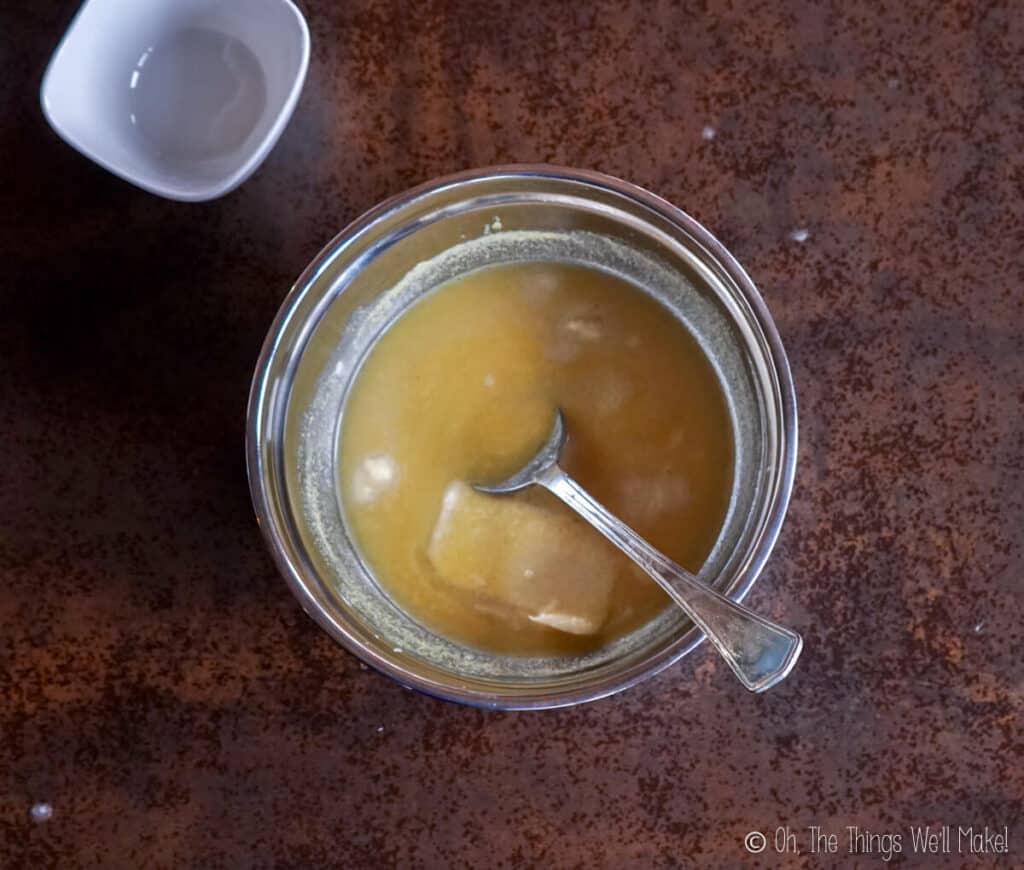
Then blend that mixed solution into the oils.




Soap at “trace”
Once we reach “trace” (when the soap is fully emulsified and looks like a thin mayonnaise), we will add our pumpkin and fragrance oils.
Then, we’ll separate around ⅓ of the mixture into a separate bowl.
At this point, we’ll add the ground spices into the soap mixture that we just separated out.
Once we have our two soap mixtures ready, we can begin to fill our soap mold. (I’m using a silicone loaf pan.) Pour half of the unspiced mixture into the mold, followed by half of the spiced, the rest of the unspiced, and finishing with a layer of spiced soap mixture.
To swirl the soaps, place a stainless steel spoon (or another utensil) into the soap.
Allow the soap to set untouched for around 24 hours. Once it’s hard enough to unmold it, gently remove it from the mold and cut it into bars.
That’s all there is to it. You should let the bars of soap cure for around 3-4 weeks before using them. (During that time, they will harden and improve.)
Customizing the recipe
Even this recipe can be slightly customized to suit your taste.
Adding color
I originally left this soap its natural golden color. This year, though, I wanted to try something new and incorporate a natural orange color by adding some ground achiote to the soap. Unfortunately, when I was ready to make it, I realized I didn’t have any on hand. So, I used paprika instead. Paprika is another way to naturally color the soap, but it doesn’t turn as orange as it would with achiote powder.
Other changes
Don’t want to use goat milk? Just switch it for another 100ml of water.
If you don’t want to do the swirl technique, you can either add the spices to all of the soap (which will result in a brown soap) or don’t use ground spices at all (for a golden colored soap).
Safety Tips
As with all soap recipes, be very careful when working with the lye solution.

- When making soap, use protective eyewear and gloves. To make the lye solution, pour the lye into the water rather than the other way around!
- Mix the ingredients together outside or in a well-ventilated area. For more safety tips, read my beginner soap recipe post.
Video

Easy Pumpkin Spice Soap
Materials
- 100 g coconut oil
- 500 g olive oil
- 80 g lye 2.8 oz.
- 100 ml goat milk either fresh or reconstituted from powdered
- 100 ml water
- 45 g pumpkin 1.6 oz., I made my own puree
- 1 teaspoon coconut sugar or any brown sugar
- 1 teaspoon salt
- 1 Tablespoon cinnamon
- 1 teaspoon nutmeg
- 1 teaspoon ground cloves
- clove essential oil & cinnamon and ginger essential oils
Instructions
Prepare the goat milk
- Place the goat milk in the freezer while weighing/measuring out the other ingredients. (You'll want to have the spices ready to go so that you aren't rushed later on.)

Prepare the lye solution
- Carefully pour the lye into the water in a stainless steel or plastic bowl. (For more safety tips, read my easy beginner soap recipe post.) Mix in a well-ventilated area. The mixture will heat up and become cloudy. Try to dissolve all (or most) of the lye before adding in the goat milk.

- After a few minutes, begin adding the cold goat milk. I like to add it when it's frozen to avoid scorching the milk. If your milk isn't frozen, you can also mix them together over a pan of ice and water. Your solution will probably yellow. That is a normal reaction of goat milk and lye.

- Add the sugar and salt to the lye solution. Once the solution is thoroughly mixed, allow it to rest while you get together the other ingredients.

Combine the lye solution and the oils
- Melt the coconut oil if it is in a solid state. Then, combine the oils in a large bowl.

- Add the lye solution to the oil mixture, and gently mix them together.

- Once the lye solution is incorporated into the oils, carefully mix them together with an immersion blender. The mixture will become creamy looking and, after a few minutes, will thicken into a thin, mayonnaise-like texture. (If your ingredients are cold, it will take a bit longer.) At this point, it's called "trace." We can now add in other ingredients.

Add in other ingredients
- Add the pumpkin puree to the soap mixture. If you want to add an orange pumpkin color, now is the time to add in some achiote powder (start by mixing in a small amount and add more as desired) or a soap colorant.

- Add the essential oils or cosmetic grade fragrance oils, if you prefer. Certain essential oils, like clove oil, may cause your soap to thicken more quickly, so be prepared, just in case. I didn't find it to be an issue, but it may depend on the oil. You can experiment here, and use your nose to help guide you. I used mostly clove oil, followed by some cinnamon and ginger oil. 😉

- Separate out about ⅓ of the soap mixture into a separate bowl. Add the ground dried spices to the ⅓ that you separated out. Mix well to fully disperse them in the mixture.
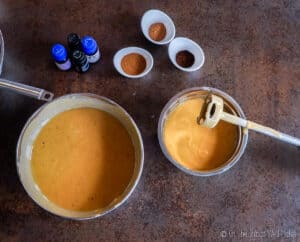
Pour into molds
- Pour about half of the un-spiced soap mixture into your mold. (I'm using a silicone loaf pan.)

- Add a layer of the spiced soap using about ½ of the spiced soap mixture. If it appears to fall to the bottom in one area, carefully spoon it over the top to completely cover the unspiced layer.

- Cover that layer with another layer using the rest of the un-spiced soap mixture. Then, cover that, as before, with the rest of the spiced soap.
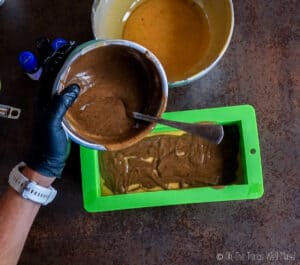
Swirl the soaps
- Using a spoon or some other utensil, poke into the soaps, reaching for the bottom layer and pulling the soap out over top, trying to gently swirl the soaps in certain places. You can also zigzag your way through the soap in places, to have the soaps gently swirl together, without fully mixing them into each other.

- Once you've gently swirled all over the soap, allow the soap to rest for at least 24 hours.

Unmold and cut the soap
- After 24 hours, you can begin to check the soap to see if it's hard enough to be gently unmolded. If it is too soft, wait another day and check on it again. Once hard enough, gently unmold it. (Don't wait too many days or it may be difficult to cut into bars.)
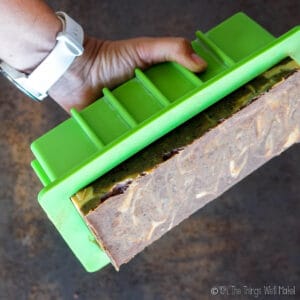
- Once you've removed the block of soap from the mold, cut it into bars. You can make your soaps as thin or as thick as you like.

Curing the soap
- Place the soap on parchment paper or cardboard with air space between the bars. Allow them to cure for several weeks, ideally at least 3-4 weeks. During this time, the soap will harden and the crystalline structure will continue to form. To help the soaps dry thoroughly on each side, flip the bars of soap every couple of days at first. Once cured, it's ready to use like any other soap. Enjoy!
 Español
Español









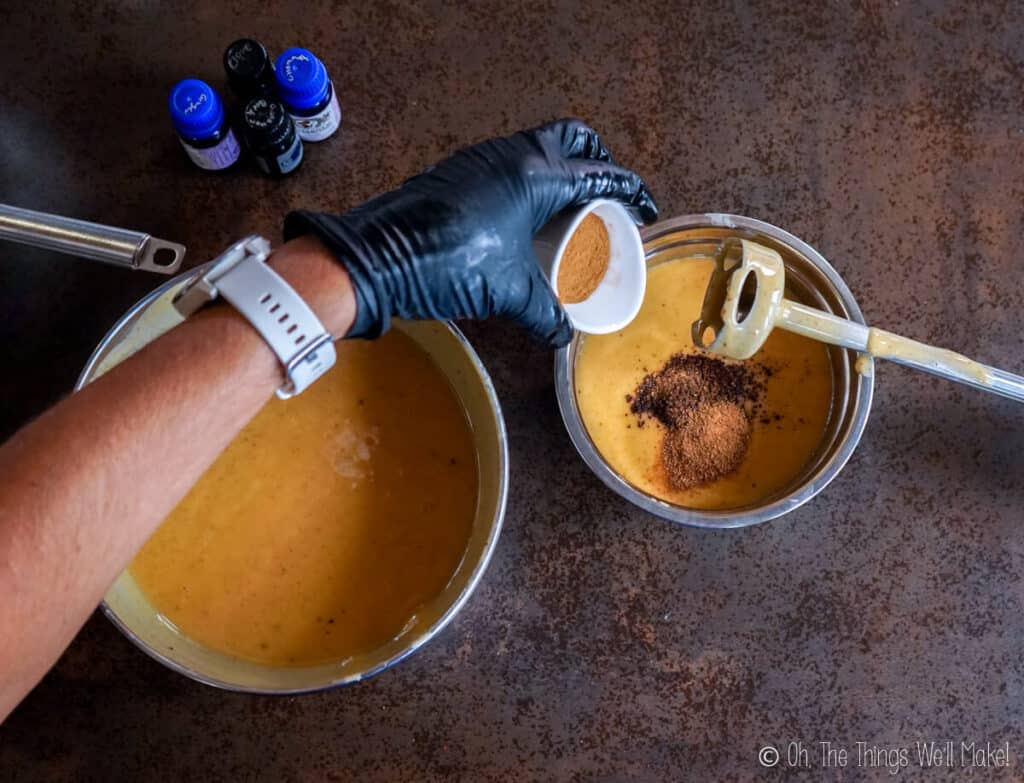

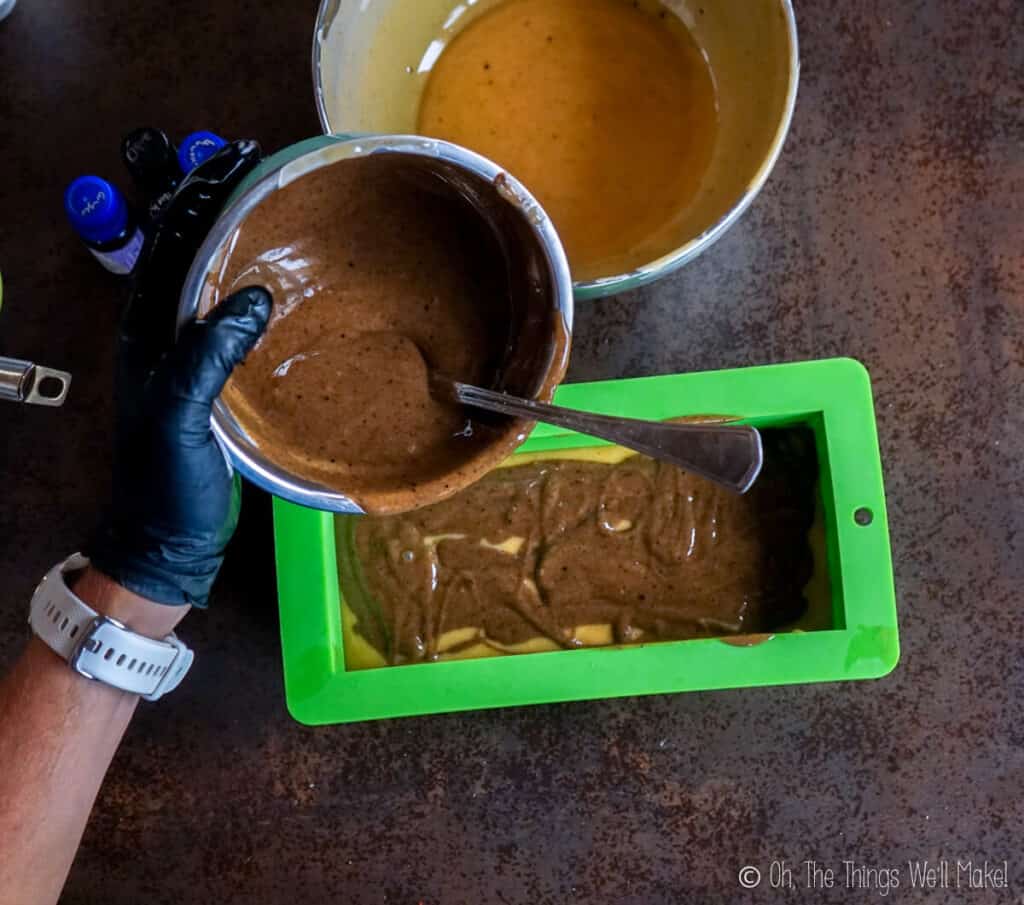
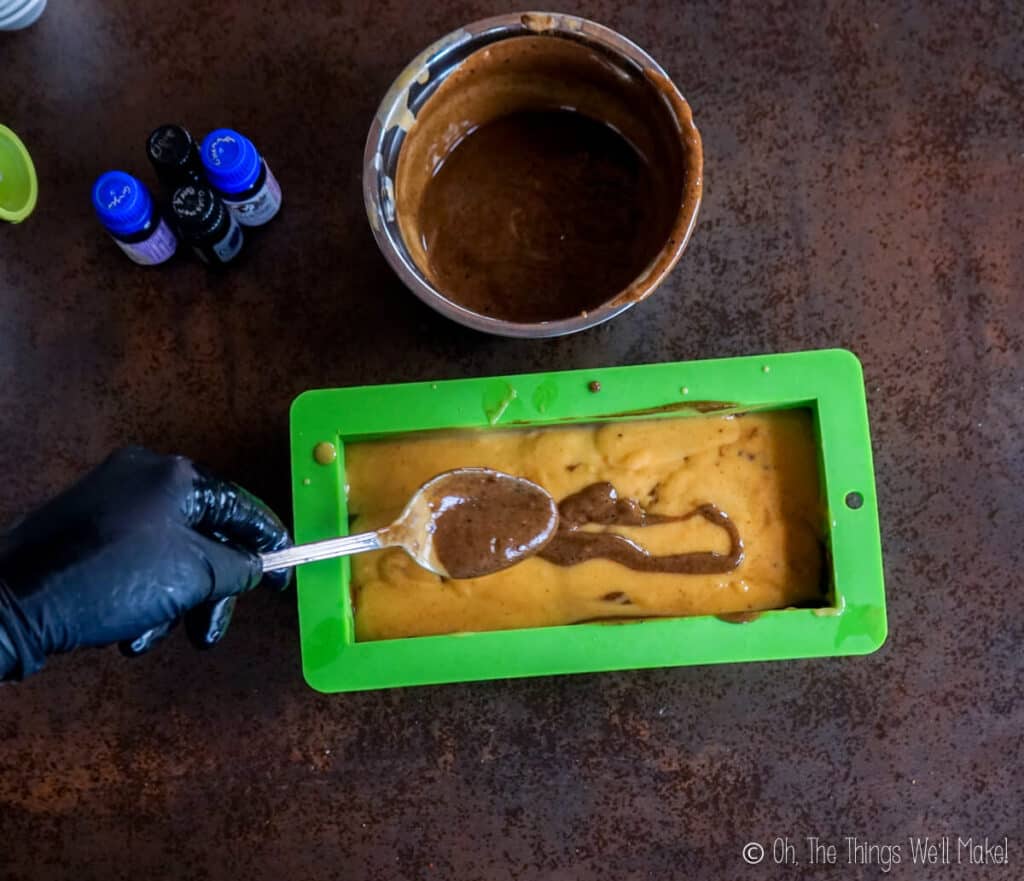



 Making an Easy, Basic Beginner Soap, and Then Making it Fun!!
Making an Easy, Basic Beginner Soap, and Then Making it Fun!!
liz
i guess i should have made sure i had thought of all the questions i would have for you – can i skip the ginger EO as its one i dont have – will it make that much of a difference to the perfume – and – is it right that if you freeze your goats milk before adding the lye to it – it stops the milk from burning with the heat created by the lye????thanks
Tracy Ariza
Hi Liz,
Thanks! Yes, I really like this soap. It’s still a very simple and easy to make soap, but start to test out working with new ingredients like milk, and has a long working time, so you can add in the spices and play with trying to swirl a soap without it getting too hard on you right away.
Yes, you understood right the part about freezing the milk. Just as mixing water and lye will give you a solution that will heat up pretty quickly, so will mixing lye with milk. The sugars in the milk can burn from that heat, but if you freeze the milk, it helps keep it from heating up enough to burn it. I also used an ice bath around the mixing vessel. Doing both may be an overkill, but I like to err on the side of doing too much. 😉
As for the ginger EO, I wouldn’t worry too much about it. I think it’s the one I used the least in the mix. Some pumpkin spice mixes include ginger, some don’t. I used a lot more of it in the gingerbread soap, of course.
I don’t think it will make too much of a difference at all. Just mix the others to your liking. The cloves and cinnamon give off a very strong scent, and you probably won’t miss the ginger at all.
And good luck! This has always been one of my favorites.
Brenda Alfery
Can this soap be made with Hot Process method
Tracy Ariza
Hi Brenda,
You should be able to make this soap using the hot process method, but I’m a bit curious as to why you would want to.
It really only makes for an uglier bar of soap, is a much messier process, and is a bit of a waste of energy in my opinion.
Either method makes a soap that “can” be used within a couple of days (the saponification process is finished immediately with the hot process and within 2-3 days with the cold process), but that shouldn’t be used for at least several weeks. The soap will continue to harden and improve with time in either case. I’ve never really understood why some people like the hot process method so much because I don’t really see it having any benefit. I personally hate it. 😉
liz
wow – this looks amazing – i am new to soap and this sounds right down my track – will read and read your instructions and look at the queries you have just to make sure i do it right – i love the smells of autumn and spices – thanks again
Natasha
This looks so lovely! Thank you for the head’s up about some essential oils causing the soap to thicken more quickly. That’s interesting/good to know!
Tracy Ariza
Hi Natasha,
With this recipe, it shouldn’t be too much of a problem because I used a recipe that I knew had a pretty extended working time. That said, it could make a huge difference in a soap that already has less working time.
If you end up making the recipe, I hope it all goes well for you. This us still probably one of my favorites- even now that I make more of a variety of recipes. 😉
Nicky
I want tomorrow today butdont have the essential oils? Will it still have the good scent if I just use the spices?
Tracy Ariza
Hi Nicky,
I don’t think you’ll be happy with the amount of scent it has without any essential oils. I haven’t tried it.
That said, I often make unscented bars of soap without any oils and I’m happy with them. If you are specifically looking to make a scented bar, I doubt that the spices alone would be enough to make a lasting scent. I may be wrong, though. I’ve personally never tried it.
If you do give it a go, I’d love to hear how it goes.
Rylee
My wife is allergic to coconut oil can you make a suggestion of what we can replace it with?
Thanks
Tracy Ariza
Hi Rylee,
With soap recipes, you have to be careful about making oil substitutions. Any changes have to be run through a lye calculator because different oils react to the lye in different measures. Plus, they each add different qualities to the soap. Coconut oil is a great oil in soaps for adding cleansing and bubbly lather qualities. It also works to make a harder bar of soap.
That said, I did a bit of investigation, and Babassu oil is what is usually suggested for people with coconut allergies. I couldn’t find any other oils with similar cleansing properties to coconut oil. Using another oil would make this already conditioning soap be even more conditioning/less cleansing. Some people are OK with that, but most like to feel “clean” after using soap. 🙂 I realize it is a less common oil, and harder to find, but it really is the perfect substitution. Coconut oil is so widely used in soap recipes because it has properties unlike most other oils.
I ran it through the lye calculator, and, interestingly enough, you can substitute it one for one in this recipe. So, if you use 100g of Babassu oil in place of the 100g of coconut oil, you can still use 80g of lye to make your soap. I hope that helps! 🙂
Dalis Marie
Hi!! Loved this recipe and im in attempt of doing it, but im a little bit scare of the milk-lye combination, could i just use the total amount of milk-water but only water? I mean no adding no milk? (Sorry for my english) thank you in advance
Tracy Ariza
Hello,
Yes! That’s completely fine!
Sorry I took so long to get back to you. We were away on vacation and just got home.
Good luck. 🙂
Sue
Thank-you, Tracy, for your quick and helpful reply. I am hopeful that the soap can be saved!
Sue
After 24 hours my Pumpkin spice soap has not hardened. It is in my wooden mold with the lid on loose. I am not new to soap making but, it is only my second attempt using frozen canned Goats Milk. I had some trouble keeping the milk/water/lye solution and the oil mix at the proper temp before combining. It did reach a mayo consistency at trace so I assumed all was well. Does it just need more time or is it a loss? Help! Please.
Tracy Ariza
Hi Sue,
Well, it’s hard for me to tell without seeing it and having been there, but there is a good chance that things will work out with time. Sometimes it does take a little longer for the soap to harden, and all works out well in the end. (Somebody else wrote me with a similar situation, and their soap did turn out well, so I hope the same goes for you.)
If you did reach a mayo consistency, and did reach trace, you should end up with soap.
If the soap turns out very soft, it could mean that there was a problem with not enough lye/a problem with the lye itself. If you end up with a very soft soap it’s because there is fat leftover after the saponification process (aka your soap is highly “superfatted”). In most cases even if there is a bit too much fat, the soap will be usable, it just takes a long time for it to harden, and it may end up always being a bar of soap that is on the softer side (albeit very hydrating).
Wait to unmold it until it hardens a little more. It may take even weeks for it to harden if you have too much fat for the amount of lye for some reason, but you should be able to unmold it before that.
I hope it works out well for you!! (fingers crossed!!)
Carmen
Thank you for showing us how to make this soap. It has all the ingredients I love. I just want to know why is lye used, and is it bad for you. I take it that it isn’t, but I was wondering. Also, does this soap leave soap scum? I was just wondering. Thanks for your answers.
Tracy Ariza
Hi Carmen,
Lye is a very strong base which is necessary for the chemical reaction (saponification) that results in soap. Without it soap cannot be made, period. There is a lot of confusion floating around because some people say they have recipes for “lye free” soaps, but that terminology is really misleading because they use a pre-made soap base where the reaction with lye has already been done for them and then add other ingredients to that. They aren’t really making soap (it was already made), and the soap wasn’t lye free- they just saved themselves the step of working with the lye themselves.
Is lye bad for you?
Well, the best way I can explain it is that it is very corrosive until you mix it with the oils. We’re used to thinking of what happens with strong acids (very low pH), but aren’t as familiar with strong bases (very high pH), but they are also corrosive. It’s not so much that it is toxic- because, if you think about it, there are foods that are made with lye. Most olives are cured in lye, and soft pretzels often get a lye bath before baking to give them their characteristic texture. The problem, though, is its corrosive nature. If it gets on your skin it can burn you, and you definitely don’t want it in your eyes. If you were to drink it, I’m guessing it could probably kill you by burning your tissues.
So, yes, you do have to respect it and be very careful when working with lye, but once it has reacted with the other ingredients to make soap, you no longer have a caustic chemical, so you shouldn’t be afraid of it. If you calculate the soap to have too much lye, meaning that some is left over after the saponification process, the soap can be too basic and can irritate your skin. With liquid soaps you can “neutralize” them by adding a bit of acid to the final soap to balance things out.
I hope that helps clear up the question of lye. Personally, I feel more comfortable about using soap (which is always made with lye) than a detergent or shower gel that is made up of many questionable chemicals.
As for the soap scum, I’m not really sure how to answer that. I’m guessing that is going to be dependent upon the hardness of your water, the surfaces of wherever you are using it, and what you use to clean up afterwards on a day to day basis. I actually read up on soap scum because it isn’t something that I notice having much of an issue with, and it appears that it tends to go along with bars of soap, and that liquid soaps don’t cause it as much. I’ve been working on making liquid soaps lately, and those recipes should be on the blog soon if you are interested. I want to use the soaps for a little while more before posting, though, just to make sure that I think they are blog worthy.
Carolyn
Hi Tracy, thanks so much for sharing this recipe and providing such beautifully detailed instructions! I love the scent and have made a batch for Christmas presents. I did make a change to the oils used in order to get a beautiful deep pumpkin orange color. I used 75 g Sweet Almond Oil; 100 g Olive Oil; 125 g Coconut Oil; and 300 g Red Palm Oil (sustainably sourced from Ecuador).
Tracy Ariza
Hi Carolyn,
Thanks so much for the tips! I love hearing what works out well for other people, and that’s a great idea to use palm oil to help add a bit of color.
At the time I originally wrote this recipe, I didn’t even think to try to color it. I was so dead set against not using artificial colors of any type, that it didn’t even occur to me to try to naturally color the soap. I don’t really like brightly colored soaps, but do like pretty, natural looking colored soaps.
Since then, I have considered maybe trying to add in a bit of paprika to give it a subtle orange hue, but it hadn’t even occurred to me to try palm oil- genius! I bet it gives the perfect color, too!
I’ve been thinking about doing a post experimenting with different natural colorings. I think it would be a fun experiment.
Something about this time of year that makes me want to make soap again- and it isn’t even just to make Christmas presents. 😉
Just yesterday I made two batches of liquid soap that I want to use for projects for around the house (and eventually the blog). I guess it’s addicting. hahaha
Carolyn
Hi again,
I didn’t mean to leave such a terse message above, but Chrome froze up and in clicking around, I accidentally submitted my partial post 🙂 Sorry! The batch I made first is curing to a pretty dark orange, so I tried another batch today using 75 g Sweet Almond Oil; 125 g Olive Oil; 150 g Coconut Oil; and 250 g Red Palm Oil (sustainably sourced from Ecuador). It seems a bit lighter which I prefer. I might continue to back off the amount of the Red Palm Oil until I find the amount that gives me the most pleasing pumpkin color.
Thanks again for all of your interesting posts, I can’t wait to hear about the results of the natural coloring’s. I am with you in preferring to use all natural ingredients.
Tracy Ariza
Are you kidding? I loved your message. 🙂
Your tips are also very helpful- especially considering that others have commented that they would like to make an orange colored pumpkin spice soap.
I’d love to hear the final recipe when you get one that turns out how you like it- I may update the post with notes about how you made it with palm oil to get a color you were happy with – and with the proportions you used, if that is OK with you.
I think some people miss important comments when there are a lot to look through as there are on this post. Commenting about it within the post would help others find your wonderful idea!
Carolyn
OK, I will let you know when I get a mix that I like best and I am totally fine with you sharing the idea in your recipe. I ound my red palm oil at a deep discount at my grocer recently, so have a lot to play with. More to come!